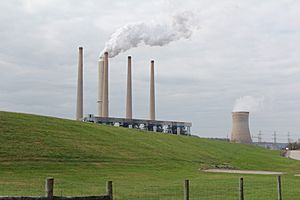J.M. Stuart Station facts for kids
Quick facts for kids J.M. Stuart Station |
|
|---|---|

J.M. Stuart Station in 2017 viewed from U.S. Route 52
|
|
| Country | United States |
| Location | Sprigg Township, Adams County, near Aberdeen, Ohio |
| Coordinates | 38°38′16″N 83°41′35″W / 38.63778°N 83.69306°W |
| Status | Decommissioned |
| Commission date | Unit 1: 1971 Unit 2: 1970 Unit 3: 1972 Unit 4: 1974 |
| Decommission date | Unit 1: 2017 Units 2–4: May 24, 2018 |
| Owner(s) | AES Ohio Generation (35%) AEP Generation Resources (26%) Dynegy (39%) |
| Operator(s) | AES Ohio Generation |
J.M. Stuart Station was a 2.3-gigawatt (2,318 MW) coal power plant located east of Aberdeen, Ohio in Adams County, Ohio. The power plant had four units and was operated by AES Ohio Generation, a subsidiary of the AES Corporation. It began operations in 1970 and ceased on May 24, 2018.
History
Construction of J.M. Stuart commenced in 1966 with Units 2, 1, and 3 beginning commercial generation in 1970, 1971, and 1972 respectively. The plant became fully operational with the completion of Unit 4 in 1974. The total cost of building Stuart was $390 million. The plant was named after James M. Stuart, a former chairman of Dayton Power & Light (DP&L). Although the plant's cooling source was the Ohio River, its discharge egressed into Little Three Mile Creek. In the 1980s, Stuart was an early adopter of the prompt gamma neutron activation analysis (PGNAA), a coal analyzer, that increased on-line reliability for the plant. In August 2014, Duke Energy sold its stake in the coal units to Dynegy. American Electric Power (AEP) held a 26% stake in the coal units through a subsidiary. Operations at Stuart were transferred from DP&L to AES Ohio Generation in October 2017.
Closure
DP&L announced plans in March 2017 to close J.M. Stuart along with its sister plant Killen Station due to economic and environmental challenges in an agreement with the Sierra Club and several unnamed parties. Electricity generation at Stuart ceased on May 24, 2018. In December 2019, DP&L sold the site to Kingfisher Development for remediation and redevelopment.
Environmental mitigation
During construction of Unit 4, a cooling tower was commissioned by Cincinnati Gas and Electric (CG&E) (a forerunner of Duke Energy) in order to meet pollution control mandates set by the State of Ohio. Its four smokestacks were upgraded with electrostatic precipitators to prevent fly ash from being released into the atmosphere. Stuart was the test site for the Low-NO
x Cell Burner (LNCB) designed by Babcock & Wilcox. The LNCB project utilized Unit 4 over a duration of 53 months from 1990–1994. The test confirmed that a LNCB can reduce nitrogen oxide (NO
x ) emissions by more than 50%, but the carbon monoxide (CO) emissions were inconclusive. Each unit at Stuart were retrofitted with selective catalytic reduction (SCR) systems between 2003–2004 by Black & Veatch. The SCRs were installed to comply with the Clean Air Act's 1990 amendments and Ohio's NO
x State Implementation Plan (SIP). Flue-gas desulfurization (FGD) equipment, designed by Black & Veatch with assistance from the Chiyoda Corporation was installed at J.M. Stuart in 2008. The FGD equipment reduced 97% of the plant's sulfur dioxide (SO
2) emissions. In order to support the FGD process, a 900 ft (274 m) smokestack was constructed.
Archaeological site
The lands owned by DP&L for J.M. Stuart contain the Greenlee Tract. This tract was used by Native Americans in the past over an 8,000 year period and later settlers in the 19th Century. As DP&L looked to expand its fly ash disposal areas in the 1990s, they funded a study to determine the archaeology resources of the Greenlee Tract. Archaeology was conducted on the tract periodically from 1991–2011. Over 200,000 artifacts were collected revealing human activity from the Pre-Columbian era and from the early 19th Century.

